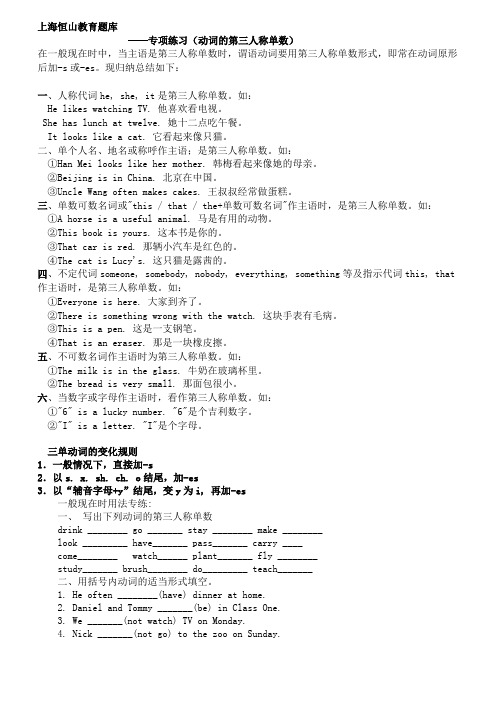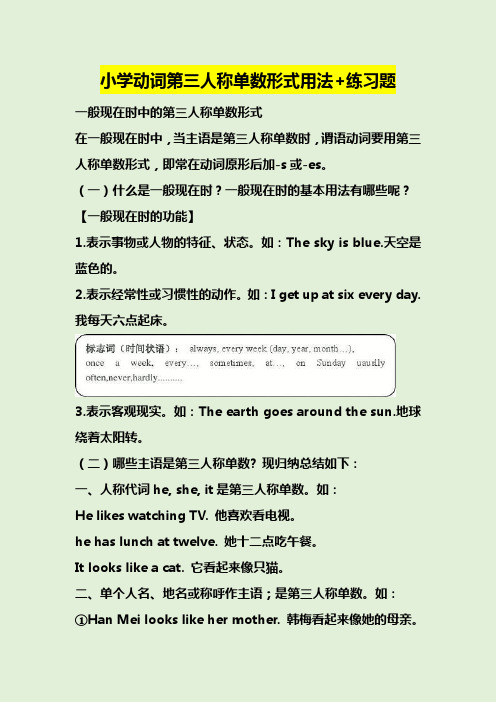一般现在时主语三单的动词变化及练习
主语是第三人称单数时,英语动词的变化规则

语是第三人称单数时,英语动词的变化规则动词,在英语众多词汇中堪称变脸的高手,遇到不同的人称、数和时态,它总会以不同的面孔登场。
本期将重点向同学们介绍在一般现在时的句子中,当主语是第三人称单数英语动词的变化规则。
一般现在时的肯定句中,主语为第三人称单数的动词变化主要体现在词尾的变化上,其规律大体有三点:1. 一般情况下,直接在动词词尾+s ,例如:get→gets; take→takes2. 以s, sh, ch, x, o 结尾的动词,在词尾+ es,例如:teach→ teaches; fix→fixes; go→goes3. 以辅音字母+ y 结尾的动词,变y 为,再+ es,如:study→ studies; try→tries除上述规律外,还应注意下面三点:1. 动词have ,遇到主语是第三人称单数时,要用has动词be 的第三人称单数形式是is。
2. 含有动词第三人称单数形式的句子变否定句时,要用doesn't + 动词原形,如:He goes to school at six in the morning. (变否定句)→ He doesn't go to school at six in the morning.3. 对含有动词第三人称单数形式的句子提问时,要用助动词does,如:She goes home at five every day. (对划线部分提问)→ When / What time does she go home every day 综上所述,只要我们洞悉了英语动词第三人称单数形式的变化规则,在一般现在时的句子中,我们都能从容应对,客随主“变”了。
大家都知道,在一般现在时中,当主语是第三人称单数时,谓语动词要用第三人称单数形式,即常在动词原形-s或-es。
但有些同学们对于哪些主语是第三人称单数还不十分清楚,现归纳总结如下:一、人称代词he, she, it是第三人称单数。
动词第三人称单数及练习

Unit5 和Unit6语法的总结和练习(一)第三人称都有哪些词呢?大家都知道,在一般现在时中,当主语是第三人称单数时,谓语动词(实意动词)要用第三人称单数形式,即常在动词原形后加-s或-es或是变y为i加es。
但有些同学们对于哪些主语是第三人称单数还不十分清楚,现归纳总结如下:一、人称代词he, she, it是第三人称单数.如:(注意句中动词的变化)1. He likes cars. 他喜欢车。
2。
She goes to school at seven. 她七点去上学.3. It has a good name。
它有一个好名字.二、单个人名、亲朋好友等称呼作主语是第三人称单数。
如:(注意句中动词的变化)1. Pat never throws rubbish on the floor。
Pat从不在地板上扔垃圾。
2。
Miss Wang waters the flowers once a day。
王老师给花一天浇水一次. 3。
Aunt Mary usually makes cakes. 玛丽阿姨经常做蛋糕。
4. My mothe r washes the dishes everyday. 我妈妈每天都洗碗。
(二)动词的第三人称单数?动词第三人称单数形式的构成:动词怎样变成第三人称单数呢?改变后怎样读?动词原形变第三人称单数的规则与发音规律同名词单数变复数大致相同。
1。
大多数动词在词尾加“s”在清辅音后发音为[s],在浊辅音及元音后发音为[z].如:①stop-stops [s] ; make-makes [s]②read-reads [z]; play-plays [z]2. 以辅音字母加“y”结尾的,要先将“y”变为“i",然后在加“es"读[iz] 如: fly-flies [z]; carry-carries [z]study-studies [z]; worry-worries3。
动词第三人称单数的变化规则及练习

动词第三人称单数的变化规则及练习一、使用情况:在一般现在时中,当主语是第三人称单数时,谓语动词要用第三人称单数形式,即常在动词原形后加-s或-es。
(标志词usually often always sometimes never every等)二、变化规则1、直接在动词后+s例如:like- likes play-plays2、以s, x, sh, ch, 接尾的动词:+es例如:wash-washes3、以辅音+o接尾的动词:+es例如:go-goes4、以辅音字母+y接尾的动词:变y为i+es例如:fly-flies以元音字母+y接尾的动词后+s例如:play-plays5、除上述规律外,还应注意下面三点:1)动词have ,遇到主语是第三人称单数时,要用has;动词be 的第三人称单数形式是is。
2)含有动词第三人称单数形式的句子变否定句时,要用doesn't + 动词原形,如:He goes to school at six in the morning. (变否定句)→He doesn't go to school at six in the morning.3)对含有动词第三人称单数形式的句子提问时,要用助动词does如:She goes home at five every day. (对划线部分提问)→When / What time does she go注意:不规则变化:have-----has,be-------is,do-----doesI 写出下列动词的第三人称单数(-s)和现在分词(-ing) godoplayjumpswimrunputsingdancecomegethaveflystudyreadwritelookdrinkeatwalklikeII选择1.Ben_____a new book.A. haveB. hasC. havesD. were2.Ben and Mary some books.A. haveB. hasC. areD. were3.I some stories every day.A. haveB. hasC. areD. were4.I __________ ice cream.A.likeB.likesC.likingD.likees5. Kitty__ English every dayA.readB.readesC.readingD.reads6.A man _____in front of his car.A.walkB.walksC.walkingD.work7.Sam’s bicycle ______a bell.A.have B has C.having D.is having8.I every dayA.swimB.swimsC.swimingD.swimes9.He his homework every day.A.doesB.doC.areD.is10. I ________ my homework every day.A.doB.isC.doesD.are11.They ________ their homework every day.A. doB.doesC. isD.are11.Lucy_______with her hands.A.touchB.touchingC.touchesD.touchs12.Superdog________the boysA.seeB.seesC.seeingD.ses13.Supergirl and Superdog______them.A.savesB.saveC.savingD.is saving14.Jack_______their cow.A.sellsB.sellC.sellingD.are selling15.Jack______up the beanstalk.A.getsB.getC.climbD.climbs16.The giant ______boys.A.eatingB.don’t eatC.eatsD.eat17.The goose_______golden eggs.yysyedyes17.The woman_______the beanstalk.A.cutB.cuttingC.are cutD.cuts18.Her mother ______the beanstalk.A.takeB.is take Ctakes D. taking19Jack andher mother _____happerA.doesB.areC.isD. have20.He____the beans in the ground.A.buyB.putsC.putD.buys二.填空:1.She ______(do) homework by herself.2.Jack ______(go) home by bike.3.The giant______(climb) up the beanstalk.4.Her mum ______(run) to the goose.5.He______(do not)like apple.6,Sam______(put) it under his arm.7.The boy_______(chase) it.8.Kitty______(watch)TV everyday.9.He______(feed)them at 8:00 in the morning.10.When ______(do)he get up?11.Grandma Wang___(live) in Pudong.12.The girls___(give) the key to Grandpa.13.That key ______(open) the old box.14.She ______(say) “I like these puppets”.15.What_____(do)Alice find?16.Which toy_____(do) she like?17.He doesn’t______(know)her name.18.John can’t_______(find) his watch.19.Where _____(do)Grandma live?20.How does he______(go)to the post office?三、请看下面两组句子,注意区分他们的共同点和不同点。
动词三单的变化规则

上海恒山教育题库——专项练习(动词的第三人称单数)在一般现在时中,当主语是第三人称单数时,谓语动词要用第三人称单数形式,即常在动词原形后加-s或-es。
现归纳总结如下:一、人称代词he, she, it是第三人称单数。
如:He likes watching TV. 他喜欢看电视。
She has lunch at twelve. 她十二点吃午餐。
It looks like a cat. 它看起来像只猫。
二、单个人名、地名或称呼作主语;是第三人称单数。
如:①Han Mei looks like her mother. 韩梅看起来像她的母亲。
②Beijing is in China. 北京在中国。
③Uncle Wang often makes cakes. 王叔叔经常做蛋糕。
三、单数可数名词或"this / that / the+单数可数名词"作主语时,是第三人称单数。
如:①A horse is a useful animal. 马是有用的动物。
②This book is yours. 这本书是你的。
③That car is red. 那辆小汽车是红色的。
④The cat is Lucy's. 这只猫是露茜的。
四、不定代词someone, somebody, nobody, everything, something等及指示代词this, that 作主语时,是第三人称单数。
如:①Everyone is here. 大家到齐了。
②There is something wrong with the watch. 这块手表有毛病。
③This is a pen. 这是一支钢笔。
④That is an eraser. 那是一块橡皮擦。
五、不可数名词作主语时为第三人称单数。
如:①The milk is in the glass. 牛奶在玻璃杯里。
②The bread is very small. 那面包很小。
第三人称单数及动词第三人称单数形式变化规则(附练习及答案)(可打印修改)

第三人称单数及动词第三人称单数形式变化规则Ⅰ. 第三人称单数主语归纳在一般现在时中,当主语是第三人称单数时,谓语动词要用第三人称单数形式,即常在动词原形后加-s或-es。
现将第三人称单数主语归纳总结如下:一、人称代词he, she, it是第三人称单数1. He likes cars. 他喜欢车。
2. She goes to school at seven. 她七点去上学。
3. It has a good name. 它有一个好名字。
二、单个人名、地名或亲朋好友等称呼作主语,是第三人称单数1. Lucy never throws rubbish on the floor. Pat从不在地板上扔垃圾。
2. Beijing is in China. 北京在中国。
3. Aunt Mary usually makes cakes. 玛丽阿姨经常做蛋糕。
三、单数可数名词作主语时,是第三人称单数。
1. A horse is a useful animal. 马是有用的动物。
2. This book is yours. 这本书是你的。
3. That car is red. 那辆小汽车是红色的。
四、不定代词someone, somebody, nobody, everything, something及指示代词this, that作主语时,是第三人称单数1. Everyone is here. 大家到齐了。
2. This is a pen. 这是一支钢笔。
3. That is an eraser. 那是一块橡皮擦。
五、不可数名词作主语时为第三人称单数。
1. The milk is in the glass. 牛奶在玻璃杯里。
2. The bread is very small. 那面包很小。
六、当数字或字母作主语时,看作第三人称单数1. "6" is a lucky number. "6"是个吉利数字。
小学动词第三人称单数形式用法+练习题

小学动词第三人称单数形式用法+练习题一般现在时中的第三人称单数形式在一般现在时中,当主语是第三人称单数时,谓语动词要用第三人称单数形式,即常在动词原形后加-s或-es。
(一)什么是一般现在时?一般现在时的基本用法有哪些呢?【一般现在时的功能】1.表示事物或人物的特征、状态。
如:The sky is blue.天空是蓝色的。
2.表示经常性或习惯性的动作。
如:I get up at six every day.我每天六点起床。
3.表示客观现实。
如:The earth goes around the sun.地球绕着太阳转。
(二)哪些主语是第三人称单数?现归纳总结如下:一、人称代词he,she,it是第三人称单数。
如:He likes watching TV.他喜欢看电视。
he has lunch at twelve.她十二点吃午餐。
It looks like a cat.它看起来像只猫。
二、单个人名、地名或称呼作主语;是第三人称单数。
如:①Han Mei looks like her mother.韩梅看起来像她的母亲。
②Beijing is in China.北京在中国。
③Uncle Wang often makes cakes.王叔叔经常做蛋糕。
三、单数可数名词或"this/that/the+单数可数名词"作主语时,是第三人称单数。
如:①A horse is a useful animal.马是有用的动物。
②This book is yours.这本书是你的。
③That car is red.那辆小汽车是红色的。
④The cat is Lucy's.这只猫是露茜的。
四、不定代词someone,somebody,nobody,everything, something等及指示代词this,that作主语时,是第三人称单数。
如:①Everyone is here.大家到齐了。
小学动词第三人称单数形式用法+练习题

小学动词第三人称单数形式用法+练习题一般现在时中的第三人称单数形式在一般现在时中,当主语是第三人称单数时,谓语动词要用第三人称单数形式,即常在动词原形后加-s或-es。
(一)什么是一般现在时?一般现在时的基本用法有哪些呢?【一般现在时的功能】1.表示事物或人物的特征、状态。
如:The sky is blue.天空是蓝色的。
2.表示经常性或习惯性的动作。
如:I get up at six every day.我每天六点起床。
3.表示客观现实。
如:The earth goes around the sun.地球绕着太阳转。
(二)哪些主语是第三人称单数? 现归纳总结如下:一、人称代词he, she, it是第三人称单数。
如:He likes watching TV. 他喜欢看电视。
he has lunch at twelve. 她十二点吃午餐。
It looks like a cat. 它看起来像只猫。
二、单个人名、地名或称呼作主语;是第三人称单数。
如:①Han Mei looks like her mother. 韩梅看起来像她的母亲。
②Beijing is in China. 北京在中国。
③Uncle Wang often makes cakes. 王叔叔经常做蛋糕。
三、单数可数名词或"this / that / the+单数可数名词"作主语时,是第三人称单数。
如:①A horse is a useful animal. 马是有用的动物。
②This book is yours. 这本书是你的。
③That car is red. 那辆小汽车是红色的。
④The cat is Lucy's. 这只猫是露茜的。
四、不定代词someone, somebody, nobody, everything, something等及指示代词this, that作主语时,是第三人称单数。
如:①Everyone is here. 大家到齐了。
一般现在时主语三单的动词变化及练习

一般现在时主语单三人称时的动词变化①在一般现在时中;当主语为第三人称单数时;动词要用“s”型即第三人称单数形式..②所谓动词“s”型的构成;与名词变复数相似;即:a 在动词尾直接加 s..如:play—plays; want—wants; work—works; know—knows; help—helps;get—getsb 以字母s、ss、x、ch、sh或o结尾的动词加-es;如:guess—guesses; fix—fixes; teach—teaches; brush—brushes; go—goes;do—does;watch —watches;catch—catchesc以辅音字母+y结尾的动词;先变y为i;再加-es..如:study—studies;carry—carries;fly—flies;worry—worries第三人称单数练习一.请选出正确的答案:1. She like / likes to play football.2. He like / likes drinking milk.3. I like / likes to watch TV.4. We like / likes to play badminton.5. They like / likes to sing songs.6. She read / reads books every day.7. He play / plays computer games every day.8. It listen / listens to the radio every day.9. Linda draw / draws pictures every day.10. Jane and Linda play / plays football every day.二.请用动词的适当形式填空..1. Let him _____playbasketball.2. Everyone_____knowwhat he really like.3. Those girls____bemy sister.4. That girl_____callme every Sunday.5. How___doshe_____spellthe word6. He________ TV every evening. watch7. We always ________ to school on foot. go8. Tom; with his classmates; often ______ football after school. play9. Your shoes _______ under the bed. be10. ______ here and ______ by me. come; stand11. His uncle usually _________ to work by bus. go12. I always ______ up at six in the morning.get13. John ________ like his father. look三.请用 have或has填空..1.I ________ a nice picture.2.He ________ a good friend.3.They _________ some kites.4.We ________ some flowers.5.She __________ a duck.6.My father __________ a new bike.7.Her mother _________ a vase.8.Our teacher _________ an English book.9.Our teachers _________ a basketball.10.Their parents __________ some story books.11.Nancy _______ many skirts.12.David ________ some jackets.13.My friends ________ a football.14.What do you ________15.What does Mike ________四.否定句:在动词前+doesn't或don't.1. She_____ _____doher homework every day.2. He_____ _____livein Shanghai.3. He_____ _____needa pair pf shoes.4. Danny_____ _____seethe apple tree5. She_____ _____comefrom America.6. The girl_____ _____lookout of the window and sees many birds in the sky.五.Do还是Does我来选 ..1. Do/Does______ he watch TV at night Yes he does.2. Do/Does______ you go to s chool everyday No; I don’t.3. Do/Does______ Jack and Peter like apples4. Do/Does______ Tina go swimming on Sunday5. Do/Does______they play football Yes; they ___do/does.6. Do/Does______ we have a good teacher Yes; we ____do/does.7. Do/Does_____ they jump rope No; they ___do not/does not.8. Do/Does_____your dog walk in the zoo9. Do/Does____ I have a big nose No; you _____do not/does not.10. Do/Does____ your cats eat fish Yes; they _____.do/does.11. Do/Does_____ their mothers go shopping No; they ____do not/does not.12. I ___do not/ does not speak Japanese. Do/Does _____you speak Japanese 六.请用动词的适当形式填空..1._____the desk_____havefour legsYes; it does.2._____she____doher homework every dayYes; she does.3._____he_____livein JinanNo; he doesn't.4._____he_____needa pair of shoesNO; he doesn't.5. Does Danny_____seethe apple tree6._____she_____comefrom AmericaYes; she_____.7._____the girl_____lookout of the window and sees many birds in the sky No; she_____.8. Jenny runs home and_____siton the chair七、选择题:1. I _____ to school every day.A. goB. goesC. going2. He _____ teeth every morning.A. brushB. brushesC. brushing3. The birds_____ singing.A. likeB. likesC. like to4. What does Lily _____ doingA. likeB. likesC. to5. _____ you like eating applesA. DoB. DoesC. Doing6. _____ he swim every afternoonA. DoB. DoesC. Doing7. Tom likes _____ in the classroom.A. singingB. singC. to singing8. –Does Sally like swimming--No; she .A. doB. doesC. doesn’t9. Peter and Mary _____ milk every day.A. drinkB. drinkingC. drinks10. _____ they read English every dayA. DoesB. AreC. Do八、把下列句子变为否定句:1. She draws pictures every day.2. We like playing football.九、把下列句子变为一般疑问句;并做肯定回答..1. Linda swims every day.2. They like playing games.。
- 1、下载文档前请自行甄别文档内容的完整性,平台不提供额外的编辑、内容补充、找答案等附加服务。
- 2、"仅部分预览"的文档,不可在线预览部分如存在完整性等问题,可反馈申请退款(可完整预览的文档不适用该条件!)。
- 3、如文档侵犯您的权益,请联系客服反馈,我们会尽快为您处理(人工客服工作时间:9:00-18:30)。
一般现在时主语单三人称时的动词变化
①在一般现在时中,当主语为第三人称单数时,动词要用“s”型(即第三人称单数形式)。
②所谓动词“s”型的构成,与名词变复数相似,即:
a)在动词尾直接加s。
如:
play—plays,want—wants,work—works,know—knows,help—helps,get—gets b)以字母s、ss、x、ch、sh或o结尾的动词加-es;如:
guess—guesses,fix—fixes,teach—teaches,brush—brushes,go—goes,do—does,watch—watches,catch—catches
c)以辅音字母+y结尾的动词,先变y为i,再加-es。
如:
1.Lethim_____(play)basketball.
2.Everyone_____(know)whathereallylike.
3.Thosegirls____(be)mysister.
4.Thatgirl_____(call)meeverySunday.
5.How___(do)she_____(spell)theword?
6.He________TVeveryevening.(watch)
7.Wealways________toschoolonfoot.(go)
8.Tom,withhisclassmates,often______footballafterschool.(play)
9.Yourshoes_______underthebed.(be)
10.______hereand______byme.(come,stand)
11.Hisuncleusually_________toworkbybus.(go)
1.
2.
3.
4.
5.
6.
7.
8.
9.
10.
11.Nancy_______manyskirts.
12.David________somejackets.
13.Myfriends________afootball.
14.Whatdoyou________?
15.WhatdoesMike________?
四.否定句:在动词前+doesn't或don't.
1.She__________(do)herhomeworkeveryday.
2.He__________(live)inShanghai.
3.He__________(need)apairpfshoes.
4.Danny__________(see)theappletree?
5.She__________(come)fromAmerica.
五.Do
12.I___[donot/doesnot]speakJapanese.[Do/Does]_____youspeakJapanese? 六.请用动词的适当形式填空。
1._____thedesk_____(have)fourlegs?
Yes,itdoes.
2._____she____(do)herhomeworkeveryday?
Yes,shedoes.
3._____he_____(live)inJinan?
No,hedoesn't.
4._____he_____(need)apairofshoes? NO,hedoesn't.
5.DoesDanny_____(see)theappletree?
A.like
B.likes
C.to
5._____youlikeeatingapples?
A.Do
B.Does
C.Doing
6._____heswimeveryafternoon?
A.Do
B.Does
C.Doing
7.Tomlikes_____intheclassroom.
A.singing
B.sing
C.tosinging
8.–DoesSallylikeswimming?
--No,she.
A.do
B.does
C.doesn’t
9.PeterandMary_____milkeveryday.。
